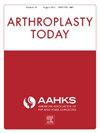Simultaneous vs Staged Procedures for Bilateral Total Knee Arthroplasty: Reduced Infection, Cost, and Readmission Rates Associated With Simultaneous Procedures
IF 1.5
Q3 ORTHOPEDICS
引用次数: 0
Abstract
Background
Many patients require total knee arthroplasty (TKA) bilaterally; however, there is limited data on bilateral procedures. This study aims to compare medical and surgical complications and hospital-related outcomes between simultaneous and staged bilateral TKA. We hypothesize that staged procedures will have superior outcomes.
Methods
This retrospective cohort study queried the National Readmissions Database, years 2016-2020, for patients undergoing bilateral TKA via ICD-10 codes. For patients undergoing staged procedures, outcomes were compared in aggregate for comparison to simultaneous operations. Multivariate regression was performed to assess complications. Negative binomial regression was utilized for 30-day readmission, reoperation, and discharge disposition. Quasi-Poisson regression was performed to assess total charges. Demographics and comorbidities, measured via Elixhauser Comorbidity Index, were controlled for in our analysis.
Results
A total of 210,682 patients, 89,568 (42.51%) undergoing simultaneous bilateral and 121,115 (57.49%) undergoing staged bilateral TKA, were included. The staged cohort had higher odds of medical complications (odds ratio (OR), 1.14; P < .001), reduced surgical complications (OR, 0.51; P < .001), and increased odds of routine discharges (OR, 1.39; P < .001). They also had increased odds of readmission (OR, 1.25; P < .001), reoperation (OR, 1.56; P < .001), and greater total charges (OR, 1.18; P < .001).
Conclusions
Our results demonstrate that, for some patients, simultaneous procedures may be a viable option. While staged operations were associated with reduced surgical complications and resulted in better discharge dispositions, they were also associated with greater medical complications, readmissions, reoperations, and total cost. Surgeons should consider individual patient risks and preferences when planning bilateral TKA.
求助全文
约1分钟内获得全文
求助全文
来源期刊

Arthroplasty Today
Medicine-Surgery
CiteScore
2.90
自引率
0.00%
发文量
258
审稿时长
40 weeks
期刊介绍:
Arthroplasty Today is a companion journal to the Journal of Arthroplasty. The journal Arthroplasty Today brings together the clinical and scientific foundations for joint replacement of the hip and knee in an open-access, online format. Arthroplasty Today solicits manuscripts of the highest quality from all areas of scientific endeavor that relate to joint replacement or the treatment of its complications, including those dealing with patient outcomes, economic and policy issues, prosthetic design, biomechanics, biomaterials, and biologic response to arthroplasty. The journal focuses on case reports. It is the purpose of Arthroplasty Today to present material to practicing orthopaedic surgeons that will keep them abreast of developments in the field, prove useful in the care of patients, and aid in understanding the scientific foundation of this subspecialty area of joint replacement. The international members of the Editorial Board provide a worldwide perspective for the journal''s area of interest. Their participation ensures that each issue of Arthroplasty Today provides the reader with timely, peer-reviewed articles of the highest quality.
 求助内容:
求助内容: 应助结果提醒方式:
应助结果提醒方式:


